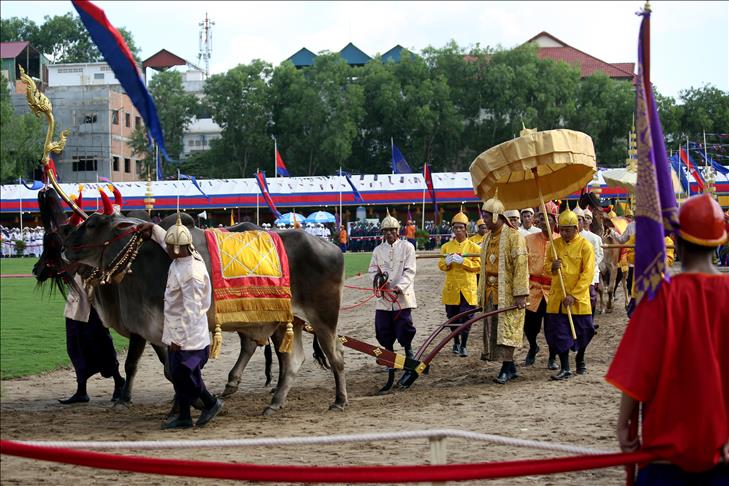Cambodia bids farewell to late king with parade for ashes
Elaborate ceremony sees Cambodian king's ashes travel to final resting spot

By Kate Bartlett
PHNOM PENH, Cambodia
A colorful parade of monks, military and three golden floats snaked through the streets of Phnom Penh early Friday morning, transporting the ashes of Cambodia's late monarch - Norodom Sihanouk - to their final resting place at the Silver Pagoda, the monarch’s official temple.
A float, shaped like a mythological hybrid beast - half lion, half elephant - and bearing Sihanouk's urn, led the way followed by two others - one in the shape of the bird, the other a semidivine Naga snake. Hundreds of people of all ages lined the sidewalks, some holding jasmine flowers or incense and photographs of the late king.
Monks in saffron robes, and dozens of Buddhist nuns dressed in white holding lotus flowers, followed the parade.
"I came today because I love my king," said 17-year-old Sin Sophea, who had come to watch the ceremony with classmates as Friday had been declared a public holiday.
While Sihanouk died at age 89 in October 2012 and was cremated the following February, his ashes have been held in the Royal Palace up until now. Following Buddhist tradition, however, they will be formally interred Saturday.
Sihanouk - whose son Norodom Sihamoni now holds the throne - wished to be interred at the Silver Pagoda, flouting the tradition of monarch's ashes being interred at a mountain temple complex in the countryside outside the capital.
On Saturday - in a ceremony to be attended by Prime Minister Hun Sen, other top officials, and royal family members - Sinahouk's ashes will be placed beside those of his daughter - Kantha Bopha - who died of leukemia in 1952 aged just 4-years-old.
While his death saw an outpouring of grief from the Cambodian populace, who revered Sihanouk as the broker of the country's independence from French colonial rule in 1953, he was a machiavellian ruler who made some questionable decisions.
After he was deposed by a 1970 coup, he threw his support behind the ultra-Maoist Khmer Rouge guerrillas, who overran the country in 1975 and whose four years of rule resulted in the deaths of an estimated 1.7 million Cambodians - either from execution or starvation.
Despite being aligned, once Pol Pot's regime came to power, they put Sihanouk under house arrest and five of his own children were killed.
During the civil war that followed the regime, the late king spent much of his time in China or North Korea- where he was welcomed warmly. He reclaimed the throne in the 1990s.
In his later years, he was an avid blogger - keeping a website where he wrote on anything from his ill health, to his favorite music, to his beloved dogs.
Anadolu Agency website contains only a portion of the news stories offered to subscribers in the AA News Broadcasting System (HAS), and in summarized form. Please contact us for subscription options.

